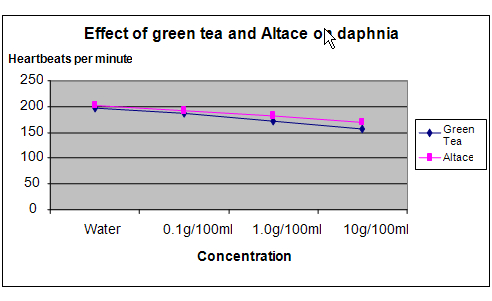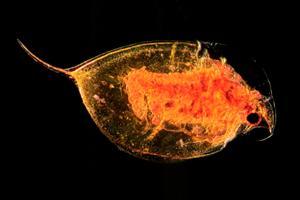| Complexity level: | 9 |
| Project cost ($): | 100 |
| Time required: | 1 hour to prepare, 1 day for science fair project |
| Material availability: | Easily found |
| Safety concerns: | None |
Hypothesis
Herbal green tea is able to reduce the heart beat of daphnia.
Overview
Green Tea
Green tea is a popular traditional drink in Japan and China. Some sources claim that it is the second most popular drink in the world after water. Herbal green tea can be purchased as tablets, capsules, powder, dried tea leaves or as bottled drinks.
A ton of research is being done to better understand the healing properties of green tea. Green tea contains several antioxidants that help to protect and prevent cell damage. It also contains fluoride, tannins and catechins. Recent studies have shown that green tea helps to prevent cancer and heart disease. It also reduces cholesterol and blood pressure. The fluoride contained in the tea helps to prevent tooth decay and tannin reduces stomach indigestion problems.
Altace
Altace is a drug that is prescribed for the treatment and reduction of high blood pressure. It is also prescribed to help prevent heart attacks and stroke. This medication does not cure high blood pressure but helps to keep it under control.
Scientific Terms
Materials
The materials required for this science fair project:
- 160 daphnia
- 7 beakers
- A packet of green tea powder
- A tablet of Altace
- A microscope
- 7 glass slides
- 1 digital weighing scale
- 1 stopwatch
- 700ml distilled water
- 1 measurement cylinder
- 1 eyedropper
- An assistant
Procedure
1. For this science project, the independent variable is the concentration of green tea and Altace solution. The dependent variable is the heart rate of the daphnia. This is determined by counting the heart beats per minute while viewing the daphnia under a microscope. The constants (control variables) are the room temperature, amount of water used and the concentration of the solutions.
2. The first beaker is labeled "water" and filled with 100ml water. The remaining 6 beakers are labeled and prepared as explained in the table below.
3.
Tea0.1 |
100ml water with 0.1gram tea |
Altace0.1 |
100ml water with 0.1gram Altace |
Tea1.0 |
100ml water with 1.0gram tea |
Altace1.0 |
100ml water with 1.0gram Altace |
Tea10 |
100ml water with 10gram tea |
Altace10 |
100ml water with 10gram Altace |
4. The daphnia are separated onto the 8 slides with 20 daphnia specimens on each of the slides.
5. 3 drops of water are added on the 1st slide and then viewed under a microscope. The number of heartbeats per minute is counted for each daphnia while the assistant monitors the time with the stopwatch. The average heart beat per minute of the daphnia is calculated by totaling all the heartbeats and dividing by 20. The result is recorded in the table given below.
6. On the next slide, 3 drops of solution from the beaker labeled Tea0.1 are added. After 15 minutes the slide is placed under the microscope and the heartbeat of the daphnia are again counted as explained in procedure 4. The result is recorded in the table given below.
7. Procedure 3 is repeated using 3 drops of solution from the beakers labeled Tea1.0, Tea10, Altace 0.1, Altace1.0 and Altace10 and placing them on different slides. The heartbeat is counted and the results are recorded in the table.

Results
The results showed that adding green tea and Altace solution reduced the heartbeat of the daphnia. The higher concentration of the solution resulted in a slower heartbeat per minute. The green tea was also able to reduce the heartbeat rate more than the Altace solution of the same concentration.
|
Solution |
Daphnia heartbeat per minute in green tea and Altace solution |
|||
|
Water |
0.1g/100ml |
1.0g/100ml |
10g/100ml |
|
|
Green Tea |
190 |
186 |
172 |
157 |
|
Altace |
201 |
193 |
181 |
168 |
Use the graph below to plot the results of the above observations.

Conclusion
The hypothesis that herbal green tea reduces the heart beat of daphnia is proven to be true.
Green tea has a lot of healing properties and it contains antioxidants that can help to protect our cells from damage by the toxins in our body. However, excessive consumption of more that 5 or 6 cups of tea a day can cause insomnia, appetite loss, irregular heartbeat, diarrhea and dizziness.
Also consider
The science fair project can also be done by using different types of herbs like garlic or ginger.
Try to repeat the science fair project by adjusting the room temperature.
References
Green herbal tea - http://theherbaldigest.com/tag/rregular-heartbeat/
Green tea side effects - http://www.greenteasecrets.com/greenteasideeffects.html
Altace - http://www.healthsquare.com/newrx/alt1014.htm
Daphnia - http://en.wikipedia.org/wiki/Daphnia

